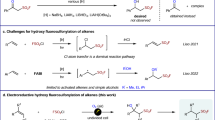Abstract
MECHANISM
IN classical organic chemistry, two empirical rules, each of limited application, summarize the regularities which have been observed to govern the formation of olefins from alkyl compounds. Hof-mann's rule (an extendBd form of the rule originally given by Hofmann), applying to primary alkyl groups in ammonium or sulphonium hydroxides, refers to the preferential production of the least alkylated of the possible alkyl ethylenes. Saytzeff's rule, relating to secondary and tertiary alkyl groups in alkyl halides, expresses the predominating formation of the most alkylated of the possible alkyl ethylenes. Having regard to the close analogy of the elimination reactions of ‘onium salts and halides, the contrary tendencies of these two rules is striking. The need for an explanation was strongly emphasized when in 1927 Hofmann's rule was rationalized as a manifestation of the inductive effect1, that is, of a very general type of molecular polarization, which must from its nature oppose the operation ofSaytzeff's rule. We have since been much concerned with the problem of reconciling and rationalizing the two rules, but the work has not been published, because, until comparatively recently, the solution was not established. An outline is now given as it may still be some time before detailed publication is possible.
This is a preview of subscription content, access via your institution
Access options
Subscribe to this journal
Receive 51 print issues and online access
$199.00 per year
only $3.90 per issue
Buy this article
- Purchase on Springer Link
- Instant access to full article PDF
Prices may be subject to local taxes which are calculated during checkout
Similar content being viewed by others
References
Hanhart and Ingold, J. Chem. Soc., 997 (1927).
Cf. Hughes and Ingold, Masterman and MacNulty, J. Chem. Soc., 908 (1940). This mechanism is identical with that which Mulliken, Rieke and Brown have recently termed ‘hyperconjugation’ and for the first time treated quantitatively: J. Amer. Chem. Soc., 63, 41 (1941).
Author information
Authors and Affiliations
Rights and permissions
About this article
Cite this article
DHAR, M., HUGHES, E., INGOLD, C. et al. Elimination Reactions in Organic Chemistry. Nature 147, 812–813 (1941). https://doi.org/10.1038/147812a0
Issue Date:
DOI: https://doi.org/10.1038/147812a0
Comments
By submitting a comment you agree to abide by our Terms and Community Guidelines. If you find something abusive or that does not comply with our terms or guidelines please flag it as inappropriate.



